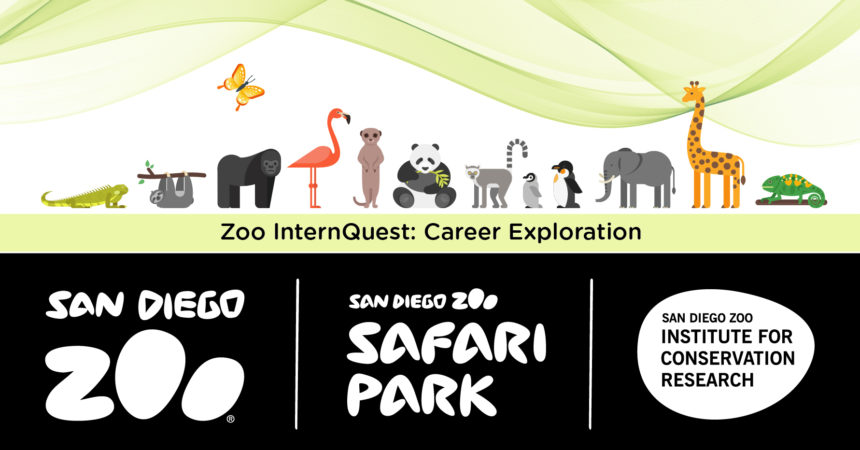Zoo InternQuest is a seven-week career exploration program for San Diego County high school juniors and seniors. Students have the unique opportunity to meet professionals working for the San Diego Zoo, Safari Park, and Institute for Conservation Research, learn about their jobs, and then blog about their experience online. Follow their adventures here on the Zoo’s website!

Where are you from? Whether you live in the Arctic Circle, savannas of Africa, or locally in California, there are animals everywhere. If you take a look into your backyard, you will most likely be met with an array of native species. Last week, we were able to meet, Amanda Wert, who is a Keeper for California condors and a raven at the San Diego Zoo. California condors are one of many species native to California. Other California native species include the pacific pocket mouse, cactus wren, and desert tortoise. Holding the record for one of the largest flying birds, California condors have wings spanning up to 9.5 feet. This measurement is longer than any human’s height from head to toe! These enormous wings help condors glide, swoop, and fly through the skies of California.
Unfortunately, in 1982, there were only 22 California condors remaining in the wild. Some of the leading causes impacting California condor deaths in the wild are lead poisoning and microtrash. California condors are scavenger birds, meaning that they will feed on carcasses in the wild. Ms. Wert laid out some tasty rat treats for the condors to simulate real rodent carcasses in the wild. When hunters use lead bullets to kill animals, lead from the bullet can spread throughout the animal’s body. Once the hunter is done obtaining what they need from the animal, they may leave the animal carcass behind with the lead bullet. Unfortunately, this is bad because there are animals that will feed on this carcass and get lead poisoning from the lead in the animal’s bloodstream or ingesting the lead bullet fragments. Another problem impacting California condors is Microtrash, which is considered to be any small pieces of trash. Examples of microtrash are bottle caps, and they can be detrimental because California condors don’t know to stay away from these small pieces of litter. Instead, California condors ingest microtrash and become ill. Regrettably, both of these problems are caused by humans. However, you can help California condors by using non-lead bullets when hunting and being responsible for picking up leftover trash after yourself.
In collaboration with other conservation organizations, San Diego Zoo Global is working hard to save California condors from extinction. In order to increase California condor population, Ms. Wert told us about Double Clutching, which is a method the San Diego Zoo has used for successful breeding. Double clutching is when an egg laid by a female condor is removed and replaced with a fake egg. This process encourages mother California condors to produce more eggs. In the span of a two-year period, the San Diego Zoo is able to raise four chicks. The real egg is placed in an incubator and hand-raised. In order to lower the chances of imprinting, which is where a wild animal can recognize humans as their parent instead of their biological parent, the San Diego Zoo doesn’t directly interact with condor chicks. Younger California condors are fed by an adult California condor puppet and recorded condor sounds are played to help in the hand-raising process. Using this process, many of the California condors raised at the Safari Park will be released into the wild. In 1992, the first zoo-bred condors were reintroduced into their native habitats in California and in 2014, the California condor population had risen to 425 individuals. Out of the 425 California condors, 200 individuals were living in the wild. The California Condors living at the San Diego Zoo and Safari Park are under well-managed care. Since California Condors are under well-managed care, they are able to live longer than California Condors in the wild. The average lifespan for a California condor in the wild is 40 years, while at the San Diego Zoo and Safari Park, the oldest California condor was 66 years old. With the use of the breeding programs, continuous care, and educating the public about these wonderful animals the San Diego Zoo is dedicated to keep California condors in the skies.
Without California condors, people and wildlife would be affected by more diseases. Since California condors are scavengers, they help maintain and regulate a variety of diseases found in rotting carcasses. In order to help increase the California condor’s population, you can change the type of bullets you use when hunting and dispose of trash in proper containers. Additionally, you can help by educating your friends and family about saving California condors because the more knowledge people have, the better they can raise awareness to protect these birds and their environment. California Condors are nature’s cleaning crew, and without their existence it would disrupt the balance of life.
Maranda, Real World Team
Week Five, Winter Session 2019


